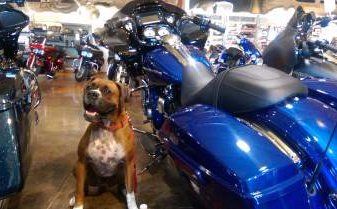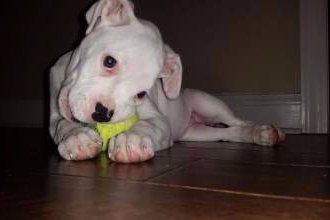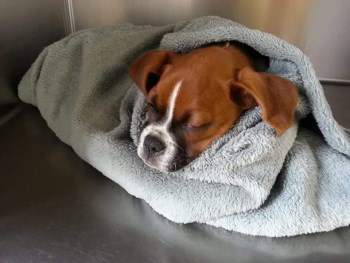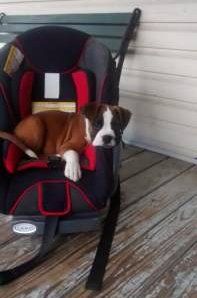First Aid
Boxer Dog First Aid Kits - Do You Really Need One?
Overview
Not everyone has a first aid kit for themselves, let alone their pets. So do you really need one for your Boxer dog? It is really worth the time to assemble one? Will it ever come in handy? Would you ever really an emergency supplies? The answers may surprise you.
One issue with lists of first aid items recommended for dogs is that more than 1/2 the items aren’t really needed for a basic kit. Since most of us don’t have extra money to assemble a kit with things that’ll never be touched, let’s sort through what you actually may need at some point in your Boxer’s life.
We’ve carved the long recommended list down to provide you with what you’ll be happy you have on hand and what is most often actually used by owners.
After all, no one plans for their Boxer dog to become suddenly ill, poisoned or injured. Having a few things put together is the wise move; it can save you the stress of running around looking for things, get your Boxer immediate help and in some cases, it can even save his/her life.
Also, if you’re traveling or heading out on an excursion with your dog, it’s a good idea to bring the kit along with you. You never know and it’s really best to prepare. No worries, the kit is rather small and easy to tuck into your travel bag.
This section will cover:
- What you should have
- What you don’t need
- Quick Reader Q&A

Abbie, 2 years old (not drunk)
Photo courtesy of James & Lynne
First Aid for Boxer Dogs - What you Really Should Have
1. Betadine Solution
- This is to have if your Boxer gets a cut. It is a fast-acting, broad-spectrum antiseptic to clean wounds and reduce bacteria that can cause serious infection. When you use it, you water it down until it has the
color of iced tea.
Why use this? Veterinarians do NOT recommend using soap, rubbing alcohol or hydrogen peroxide. Alcohol can actually damage tissue, soap is not effective and hydrogen peroxide is best used if infection has already set in.
2. Gauze pads
- Sterile gauze pads are used to apply the betadine. You’ll want to wash your hands first. Some betadine can be poured over the injury (or use the syringe or mini-baster - see ahead) and then using some gauze pads, dab at the edges of the wound. These are also used to apply pressure to a wound that is actively bleeding. You’ll want to apply pressure, stopping every 10 minutes to see if the bleeding has stopped.
3. Paw bandages
- While a cut is healing or when transporting your Boxer to the veterinarian, it’s important to keep the site clean. If a Boxer dog receives a nasty cut or injury to one of his paws, you’ll find it really hard to wrap it up without these.
While puppies can be carried, these can really come in handy with Boxers that are too big to carry and need to walk when brought to the vet with a paw injury.
These slip over the paw and are secured via a Velcro piece that wraps around the ankle. They are disposable, so it's cheap to swap them out to keep cuts clean.
Tip
- For puncture wounds, keep a damp compress on the injury as your dog is being brought to the vet; the goal is to delay the formation of any scabbing which can lock infection under the skin.
4. Antibacterial ointment
- This is good to keep a cut clean free from infection, but
use this sparingly. If a cut stays too moist, it will have a hard time scabbing up, which is necessary for healing. For many cuts, a small
amount dabbed on at night right before the puppy or dog goes to sleep is best (otherwise they just lick this off).
5. Canine rectal thermometer
- It’s really important to have one of these to properly take your Boxer dog’s temperature. You’ll need to do this if there is question of heat stroke - which is always a health concern
in the summer, or to check for a fever. We highly recommend one with a flexible rubber tip and a quick, digital readout. You may wonder if it'd be easier to get an ear thermometer; though some human ones work pretty good, we've yet to find a good pet one that is reliable one.
The normal body temperature for all puppies and dogs is 101 to 102.5 degrees Fahrenheit.
6. Petroleum jelly
- You’ll want to have this to use in conjunction with the thermometer. When you take your Boxer dog’s temperature, use this to lubricate the thermometer, which is then inserted into the anus 1/2 inch for puppies and 1 inch for adult Boxer dogs.
7. Hydrogen Peroxide
- In case of poisoning, you may be instructed to immediately induce vomiting. Please note that this is dependent on what a Boxer dog ingested; with some toxins, more damage can occur if the dog throws up and with others, it can be lifesaving to induce vomiting. If you are instructed to induce vomiting with your Boxer dog, one of the most effective methods is to give the dog hydrogen peroxide.
Check with your vet; however the recommended dose is 1 teaspoon for each 5 pounds of body weight with another dose given after 10 minutes if the dog does not vomit.
8. Activated charcoal tablets
- This is used - in some cases, to absorb toxins. If your Boxer dog is poisoned, you should call the vet ASAP for instructions. It is best to have both this and the hydrogen peroxide in case your Boxer dog eats or swallows something toxic, you know what it was and the vet tells you do administer either of these. Time is of the essence in these cases.
9. Medicine syringe
- If your dog takes liquid medicine, most likely it came with a syringe; however in cases of emergency if you need to get your Boxer dog to swallow hydrogen peroxide, you’ll want one of these.

Ajay, 6 months old
Photo courtesy of Ashley May - Nambour, Australia
An effective method (and best if you have a helper) is to pull back the facial skin to create a small pocket and deposit the liquid between the cheek and the teeth.
For large Boxer dogs, some find it easier to use a mini baster. A mini baster is also good for flushing out wounds.
10. Thermal emergency blanket
- You might never need to use this, but if your Boxer dog is severely injured (hit by a car, etc.) this can be lifesaving. Wrapping a dog in a thermal blanket can stop him from going into shock while you transport him to the animal hospital.
Tip:
Unfortunately, ambulances will not come to help a dog that is hit by a car or otherwise severely injured; you
will need to transport your Boxer dog to the closest animal hospital. An appropriately sized blanket is one of the best methods to move a puppy
or dog that is injured in this way and of course, you’ll want a helper or two. The blanket should be used as a sort of stretcher and kept under the Boxer during transport so that he can be removed from the vehicle in the same way.
11. Eye wash
- This is needed to flush a dog’s eyes of any contaminants if such an event occurs. If you are alone with your Boxer dog, it is best done by holding the bottle above the dog’s head (where he cannot see it) and letting the drops drip down into the eye. In emergency cases, if you have a helper, one can hold the bottom lid out a bit, and drops are put into the pocket of the bottom lid.
Tip
- Please note that the eye wash is a completely
different product than eye tear staining liquid or any type of cleaner like that. Those are grooming items and this is a first aid item formulated to clean and flush the eyes.

Tyson, 3 and 1/2 years old
Photo courtesy of Wes Robert
12. Artificial tears
- If you have to flush out your Boxer dog’s eyes, you’ll want to use an artificial tears product afterward to help soothe them.
13. Benadryl
- While you may have this for yourself or others in your household in tablet form, you’ll want to have liquid Benadryl for your Boxer dog. This is given in cases of moderate to severe allergic reaction to an insect bite including bees, hornets and wasps. You’ll want to use plain Benadryl (no flavoring, etc.)
The recommended dose is 1 mg for each pound of body weight, given every 8 hours; but can be doubled to 2 mg for each pound of body weight, if needed.
14. Baking soda
- If your Boxer dog has been stung by a bee or yellow jacket, a paste made of water and baking soda should be applied to the skin for 15 minutes.
If you have this in your kitchen, no need to add to the kit unless you are traveling or out hiking around, etc.
Tip:
If a wasp or hornet has stung your Boxer dog, a small piece of cloth soaked in vinegar should be applied to the bite for 15 minutes. This will help neutralize the alkaline in the venom.
What You May Not Need
If you look up lists of things to have in an emergency kit or first aid kit for pets, you’ll see a
long list.
And we certainly wouldn’t discourage anyone from obtaining
some of the items, if they have the budget to do so. The more you have, the more you’ll be prepared.
However, some of these things you either already have in your house or really don’t need at all (and some are downright ridiculous).
For some, it’s recommended only if you are traveling with your dog. And finally, for some of these the advice to use them is flat-out wrong and can make things worse.
Let’s take a look at what some suggest & why it’s not needed
(& to alleviate any possible guilt for not having all this):
5 inch hemostat
- Sometimes seen on lists as a tool to use, to clamp blood vessels to stem bleeding - If you know how to clamp a blood vessel, that’s great. If not (and really, who does other than vets, doctors & nurses?), the vet will do this if needed. Even attempting this without training could kill a dog, not help him.
Bandanna and/or nylon stocking
- This item is suggested by some to tie up a dog’s muzzle so that he doesn’t bite
after being injured; some dogs do bite when hurt as it is canine instinct to be defensive when feeling vulnerable. However, this is rare and can impede the dog’s breathing, especially a brachycephalic breed like the Boxer. While we certainly don’t want anyone to get bit from a dog that’s acting out of instinct, do use this with caution and only if absolutely necessary.
Comb
- A grooming
item in a first aid kit? 'Nuff said.
Cotton balls
- For applying antiseptic or topical medications; not bad to have but sterile gauze works better.
Credit card
- To remove stingers from bee stings, etc. It’d be hard to imagine that someone doesn’t have some sort of plastic card (bank card, license, etc.) and would need to put one in the kit.
Dish washing liquid
- Not only is there a 100% chance you already have this, it’s not recommend to flush wounds. Mixing water with betadine is best but if you don’t have any, just water is the next best thing.
Disposable safety razor
- Some suggest this for shaving fur from around a wound; this is something the vet will do, so no need for this.
Eyedropper
- Meant to apply the saline solution and artificial tears; however those usually are already in a bottle that dispenses the fluid as needed.
Flashlight and matches
- Your guess is as good as ours as to why this would be listed by so many sources. While most of us should have a flashlight, there are a lot better places to keep it other than your dog’s first aid kit.
Ice pack
- Never use this for heat stroke! You’ll want to bring your Boxer to a shady area and lay wet, cool towels over him. If inside, have a fan blowing close to him. Once his temp goes down, bring him to the vet. Packing the dog with ice will make things much worse.
While some say this should also be used to reduce swelling on injuries, if your Boxer is injured enough to have swelling, he’s injured enough to be brought to the vet.

Roxanne "Roxy" Rose, 13 weeks old
Photo courtesy of Marrissa & Chris
So, while an ice pack is good to have in the house for afterwards, though most likely you already have some in your freezer should the vet suggest applying cold to a swollen injury.
Nail clippers
- This is a grooming item and not needed in a first aid kit.
Nexaban
- Do not use this. This is skin
glue that holds wounds closed; this is not recommended at all. The vet will determine how the cut should be closed and the worst thing you can do is glue it shut, possibility trapping infection under the closure.
Paper towels
- Meant to clean up after treating cuts that are bleeding. Is there anyone who doesn’t already have this in their house?
Phone numbers of the vet and closest animal hospital
- Not needed for an at-home kit. However, if you’re traveling with your Boxer or taking him out (hiking, etc.) it’s good to have. If your phone dies, you’ll be happy you have the numbers written out on paper. Also, if you’re far from home, get the number of the closest vet where you are staying.
Q-tips
-
Not needed in a first aid kit.

RJ, at 1 year, 6 months
Photo courtesy of Brandi Lavender, Alabama
Rolled gauze
- This is on a lot of lists meant to stabilize joints and such. If a Boxer were to suffer a broken limb, you don’t want to be wrapping it up. You can do more damage and it can cut off blood circulation.
Rubber gloves
- If you wash your hands before assisting your Boxer dog with an injury, you really don’t need gloves. The betadine can stain a bit, so some owners may want these.
Rubbing alcohol
- One ‘suggested’ use is to cool down a dog’s body in case of heat stress. This is NOT recommended by us. A cool, shaded area (if outside) or near a fan (if inside) and the use of cool, wet towels placed over the dog’s body is best, while you are waiting for his temp to go down in order to safely transport him to the vet.
The other possible use would be for wound cleansing and again, this is not recommended as it can damage a dog’s skin.
Scissors
- Meant to trim fur around an injury, this is not really needed since any deep cut or wound will be flushed and compressed while you head to the vet. The vet will shave the area if stitches need to be given.
Sterile needle
- On lists to remove ticks; not really needed since tweezers work best.
Styptic powder
- A grooming product to stop bleeding if a nail is cut too short; you should have this if you clip your dog's nails yourself, however these are not needed in the kit.
Tweezers
- To remove ticks. Most of you already have this in your bathroom.
Waterproof Kit Container
- If you are putting your Boxer’s kit together, it certainly can’t hurt to have it in a waterproof container; however this will only be useful in case of a flood (or boating accident?). Not really needed in most cases.
Summary on First Aid Kits
Almost zero dogs go through their lives without some sort of event (bee sting, cut, etc.).
And it’s literally impossible to know when an accident is going to happen and it’s normal to feel panicked when it does.
The best thing you can do is some prepping so that if something occurs you can have what you need at hand and be in the best position to quickly help your Boxer.
Quick Reader Q&A Regarding Cuts & First Aid
Q: My Boxer keeps getting cuts and scrapes on his paws
and my family’s in debate regarding this. Half of us say that we need to toughen up the paws to make the skin stronger. The other half of us thinks we need to protect the skin so he stops suffering from the nicks and cuts. I won’t say which half I’m on til you can answer. Thanks in advance.
A:
This is a really good question and it a common one too. The answer is actually somewhere in between. It is true that paw skin
can toughen up over time. You’ll want your Boxer to be walked over a variety of different surfaces… pavement, grass, sand, rocky terrain, etc. Over the course of time, the paws will adapt and become tougher. However, you want this to happen due to experience, not to actually injury.
If a Boxer dog is walked over surfaces that damage the paws or is walked once damage occurs, this will be counterproductive and the paw skin will not strengthen at all. In fact, cuts and scrapes on the paws can quickly escalate to infected cracks.
Paw skin is not even close to being indestructible and is able to become injured due to hot pavement in the summer, too much time on very cold ground surfaces, tiny rocks that cut and scrape the skin, salt in the winter, ice melt (which can cause chemical burns) and even hard snow pieces that get wedged between the pads.
We always suggest using paw wax. It moisturizes the skin, heals drying & cracking issues and protects. It only has to be applied about twice a week and a quality wax absorbs quickly, so its relatively hassle-free.
Q: My Boxer dog got a good sized cut on his nose.
It bled a lot. Now it’s been 3 days and it doesn’t seem to be healing because he keeps licking it. Should I keep putting Neosporin on it even if he licks it off?
A:
Cuts on the nose can bleed a lot since there are a lot of capillaries there. We’ll go over the steps of what to do for a cut on a Boxer’s nose for everyone reading this:
1.
Apply pressure to stop the blood. It’s best to use sterile gauze pads. Apply pressure for about 10 minutes, then check. During those 10 minutes, if the blood goes through the gauze, don’t lift it off, just add more. If it’s still bleeding when you check it, do another 10 minutes. If blood is still flowing after that, the cut most likely needs to stitched by the vet.

Atticus, 9 weeks old
Photo courtesy of Anthony Klintworth
2.
Once bleeding has stopped, gently flush the cut using betadine mixed with water
(add water until it is watered down to look like the color of iced tea) using a bulb or plastic syringe. If you don’t have this, you can dab it (not wipe) with gauze pads and betadine.
3. Apply a thin strip of antibacterial ointment. As mentioned in the original question, dogs do lick their noses quite a bit (hundreds of times a day) and even more so when there is an issue like a cut. So, it’ll be best if this is reapplied each night, just as the puppy or dog has fallen asleep.
4.
If it oozes any pus, if the skin is raised or red or if it is not showing any signs of healing after 3 days, you’ll want the vet to take a look. It may need to be butterfly bandaged, it may need stitches and/or medication for infection may need to be given.
Popular Pages:
How to Clean Boxer Dog Eye Discharge
- Does your Boxer wake up with a bunch of goo on his eyes? Read what is normal, what is not and how to clean this.
Boxer Dog Has Weird Color Urine
- What it means if a dog's pee is dark yellow, white, foamy, tinted red and more abnormalities with urine.
How Much Water Does Boxer Dog Need
- Keeping your Boxer hydrated is important. Read about water requirements.
AllBoxerInfo.com All content is protected by US and International copyright laws. All rights reserved.
We are a participant in the Amazon Services LLC
Associates Program, an affiliate advertising program designed to provide a means for us to earn fees by linking to Amazon.com and affiliated sites.
